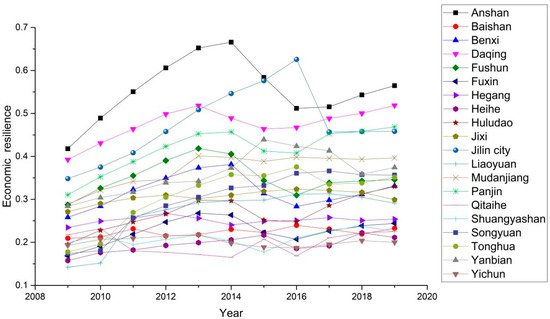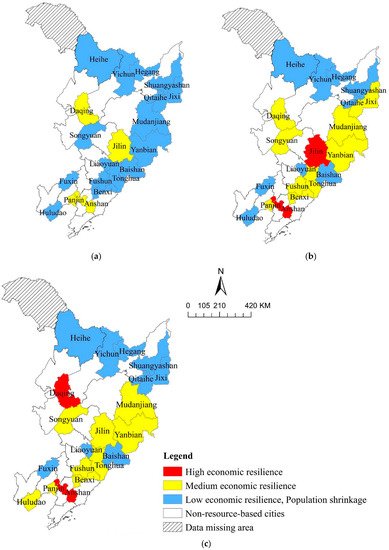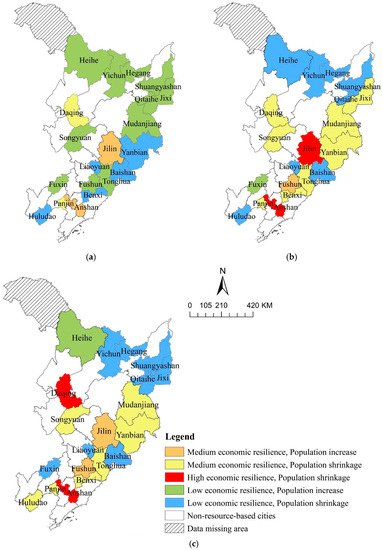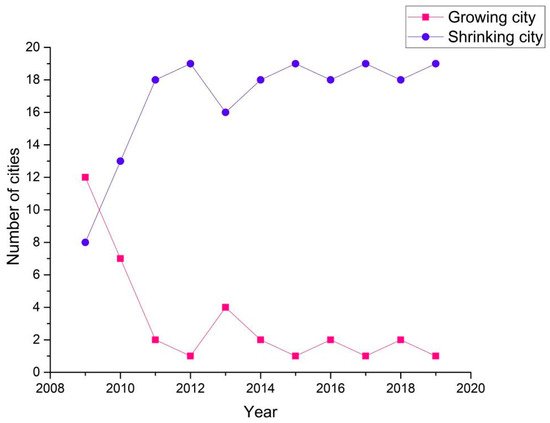You're using an outdated browser. Please upgrade to a modern browser for the best experience.
Please note this is a comparison between Version 1 by Mingke Xie and Version 2 by Rita Xu.
The term ‘resilience’ originates from physics, engineering and ecology. Resilience emphasizes the ability of a system to maintain stability and to gradually recover to its original state in the face of external interference. Later, this concept evolved to include economic resilience after being introduced into economics and geography; now, resilience has become a new research hot spot.
- northeast China
- resource-based cities
- shrinkage
1. Introduction
In the process of economic development, cities or regions are always subjected to various disturbances and shocks [1][2]. For example, shocks such as economic crises, natural disasters, epidemics and market changes pose great challenges to the development of an economic system. Economic resilience helps to explain why some regions can quickly recover or even realize growth after the shock, while other regions gradually decline after the impact of the shock [2][3]. Economic resilience is of vital importance for measuring the ability of a city to withstand various risks and to recover from damage, and also with regard to sustainable development and the formulation of policies.
In the planned economy era, the resource-based cities in northeast China exploited a large number of natural resources, which provided a solid guarantee for China’s economic development and energy supply [3][4]. Under the development mode of resource burning, resource-rich cities ushered in the spring of economic prosperity. However, at the same time, many hidden dangers were buried. The way in which these cities emphasized development over governance triggered a serious ‘man–land’ contradiction. Moreover, the depletion of resources resulted in the gradual disappearance of the traditional advantages upon which resource-based cities rely. Thus, resources became the bottleneck, rather than the driving force, for the development of resource-based cities, leading to a series of urban problems, such as the resource curse [4][5]. Plagued by many factors, including resource exhaustion, a single industrial structure, lack of innovation and rigid administrative systems, the economic development level of resource-based cities in northeast China has fallen sharply. A large number of people have also lost their jobs, and the average wage is decreasing. These phenomena lead to a large level of population outflow, leaving the economy vulnerable to future economic shocks. The negative effects of this outflow are fed back to the urban economic system, deepening the existing social and economic problems even further.
It is commonly believed that population shrinkage tends to exert negative influences on the society and economy, but few have deeply studied its socioeconomic effects. In this articlentry, the hypothesis that population shrinkage has negative effects on economic resilience is proposed and then confirmed with resource-based cities in China as research areas. The reasons why resource-based cities in northeast China are taken for empirical analysis in this entrstudy are as follows: (1) Resource-based cities in northeast China are plagued by location marginalization and resource exhaustion. They lack the endogenous impetus necessary for economic development, and thus, it is more likely that they will show poor economic resilience after economic shocks. (2) Resource-based cities in northeast China have socioeconomic problems that cannot be ignored. Most of these cities are suffering from severe population loss, which is a typical situation found when explaining and understanding shrinkage. (3) Compared with cities in other regions, resource-based cities in northeast China more clearly combine the two factors of low economic resilience and population shrinkage. As such, these cities serve as the subject of the question, “How does population shrinkage affect economic resilience?” To answer the question, the following research was conducted by building an index system of economic resilience and applying a mediation effect model.
2. Characteristics of the Economic Resilience of Resource-Based Cities in Northeast China
2.1. Temporal Characteristics
Based on the proposed index system, the economic resilience of each city is calculated from 2009 to 2019 (Figure 1). As can be seen from the figure, the overall trend of the economic resilience of resource-based cities in northeast China was first upward trend, then downward, and finally stable, with 2013 and 2016 as the dividing years. From 2009 to 2013, China released policies to help northeast China fight the economic crisis. Cumulative fiscal transfer payments, as well as the reforms of the markets and functions of the governments from The Twelfth Five-Year Plan all contributed to the improvement of the ability of resource-based cities in northeast China to resist economic risks. From 2013 to 2016, the New Northeast Phenomenon emerged. This means the overall economy of cities in northeast China was weak, and its transformation power was insufficient in the face of the deepening social and economic transformation in China. Against this background, the original development models of resource-based cities in northeast China could not satisfy the demands at that time from their society and economy, leading to the continuous decline of their economic resilience. From 2016 to 2019, many resource-based cities in northeast China began to transform and expand the external effects of transformation. For example, industrial and mining cities tried to develop complementary industries, such as equipment manufacturing, ship supporting or industry-and mine-based tourism. Forestry cities managed to start forestry economy, pension industry based on ecology and ice-snow tourism industries. Even if resource-based cities had made progress to a certain extent during the process of transformation, there is still room for improvement. In general, during the past 11 years, the economic resilience of resource-based cities in northeast China has shown obvious stage characteristics, which are, to a large extent, closely related to national policies. Their endogenous factors are not sufficient for urban development.


Figure 1.
Change of economic resilience of resource-based cities in northeast China.
2.2. Spatial Characteristics
The years 2009, 2014 and 2019 were chosen for the analysis of the spatial differentiation of the economic resilience of resource-based cities in northeast China (Figure 2). Three classes of economic resilience have been divided for comparison purposes, namely low class (0–0.3), medium class (0.3–0.5) and high class (0.5–0.7). From 2009 to 2019, the spatial gradation of economic resilience gradually became obvious. The number of cities with medium and high economic resilience increased; these cities are mainly located along the Hunchun–Ulanhot Expressway and the Hegang–Dalian Expressway. Five cities on the border of Heilongjiang Province, Baishan and Liaoyuan in Jilin Province, and Fuxin in Liaoning Province were in a state of low economic resilience. In 2009, the overall economic resilience of resource-based cities in northeast China was low. Most cities (except for Daqing, Jilin, Panjin and Anshan) had low economic resilience, indicating that most cities took a hit during the economic crisis. In 2014, the differentiation among the three classifications was more obvious than in 2009. The economic resilience of many cities had improved, as a result of the support of national policies. Among these cities, Jilin and Anshan were of high economic resilience in 2014; several cities with medium economic resilience are closely distributed around these two cities. Meanwhile, the cities with low economic resilience are mainly distributed near the border of northeast China. In 2019, the grading characteristics were similar to those in 2014, with the economic resilience grades of Jilin and Jixi declining, Daqing and Huludao improving, and the economic resilience grades of the rest unchanged.


Figure 2.
Spatial differentiation of the economic resilience of resource-based cities in northeast China. (
a
) 2009; (
b
) 2014; (
c
) 2019.
3. Impact of Population Shrinkage on the Economic Resilience of Resource-Based Cities in Northeast China
3.1. The Relationship between Population Shrinkage and the Economic Resilience of Resource-Based Cities in Northeast China
35.1.1. The Spatial Matching of Population Shrinkage and Economic Resilience
Based on population shrinkage and the classification of economic resilience, there are five spatial types (Figure 3). Analyzing the trend of each type, from 2009 to 2019, one can see that small changes occurred in the numbers of cities whose economic resilience belonged to the medium class. The population of those cities increased, while the cities whose economic resilience belonged to the high class saw their populations shrink. There were major changes in the numbers of cities: (1) whose economic resilience belonged to the low class and the populations of which shrank, (2) those whose economic resilience belonged to the low class and the populations of which increased, and (3) those whose economic resilience belonged to the medium class and the populations of which shrank. As can be seen from the figure, these three types of cities with major changes are distributed in an inverted “L” shape around Jilin, Anshan, Fushun and Daqing. The number of cities whose economic resilience belonged to the low class and the populations of which shrank changed from five in 2009, to eight in 2014 and 2019. The number of cities whose economic resilience belonged to the low class and the populations of which increased experienced a drastic change. There were 11 such cities in 2009, and just one such city in 2014 and 2019. The number of cities whose economic resilience belonged to the medium class and the populations of which shrank also experienced a major change. There were only two such cities in 2009, but that figure increased to eight in 2014, and seven in 2019. Cities whose populations shrank tended to have lower levels of economic resilience if judged solely from the perspective of the number change in spatial types. However, is this a reasonable conclusion? Did a relationship exist between population shrinkage and economic resilience? If so, what are the mechanisms between them? The following research will answer these questions.


Figure 3.
The matching types of population shrinkage and economic resilience of resource-based cities in northeast China. (
a
) 2009; (
b
) 2014; (
c
) 2019.
3.1.2. The Correlation between Population Shrinkage and Economic Resilience
In response to the question in the previous section, “Did a relationship exist between population shrinkage and economic resilience?”, a Spearman correlation analysis was applied to quantify the relationship between them (Table 3). It is generally believed that when the correlation coefficient falls between 0 and 0.2, two variables are irrelevant. When the correlation coefficient falls between 0.2 and 0.4, the correlation is weak; when the coefficient falls between 0.4 and 0.6, the correlation is moderate; when the coefficient falls between 0.6 and 0.8, the correlation is strong, and when the coefficient falls between 0.8 and 1, the correlation is high. As can be seen from Table 1, the correlation between population shrinkage and the economic resilience of resource-based cities in northeast China increased with time. Since 2011 and 2013, a significant weak correlation and moderate correlation has been shown between them; this is also consistent with the number trajectory of regional resource-based cities’ shrinkage and growth (Figure 4). Since 2011, the number of resource-based cities that are shrinking has maintained at a high level, indicating that the prerequisite for the correlation to be significant is that the number of shrinking cities stays at a stable level. The relationship between population shrinkage and economic resilience is complicated; they are the cause and effect of each other. This enstrudy mainly focuses on how population shrinkage affects economic resilience. In order to ensure the significance and sufficiency of the samples for the following model, the period from 2013 to 2019, with moderate correlation and relatively sufficient samples, was selected.


Figure 4.
Number trajectory of the population shrinkage and growth of resource-based cities in northeast China.
Table 1.
The correlation between population shrinkage and the economic resilience of resource-based cities in northeast China.
| Period | Spearman Coefficient | Sig. | Sample Size |
|---|
** means that the influence is significant at 0.01 level.
3.2. The Paths by Which Population Shrinkage Affects Economic Resilience
A mediation model was used to examine the paths by which population shrinkage affects the economic resilience of resource-based cities in northeast China. As shown in Table 2, population changes have a significant positive effect on economic resilience, based on the total effect (the regression value is 3.797, passing the 1% test of significance). That is, against the background that most resource-based cities shrink, the more the population shrinks, the lower is the economic resilience. In addition, population shrinkage has significant negative effects on industry productivity, population consumption, innovation ability and culture construction. Population shrinkage also strengthens these cities’ dependence on their natural resources, whereas the relationship between population shrinkage and environment quality is not significant. For this paper, six mediating variables were put into the mediation model, first one-by-one and then together. The results are shown in Table 3. Industry productivity, population consumption, innovation ability and culture construction exerted positive partial mediation effects on the influencing paths; the mediation effects of resource dependence and environment quality were not obvious. By comparison, the mediation effect value of innovation ability was the highest (0.726), followed by those of industry productivity (0.655), culture construction (0.571) and finally population consumption (0.491).
Table 2. The allocation effects of population shrinkage on mediating factors.
| Variable | Total Effect | Allocation Effect | |||||
|---|---|---|---|---|---|---|---|
| ER | AGDP | PCSR | RD | INNOV | CI | AQI | |
| 0.049 | |||||||
| 0.039 | |||||||
| 0.032 | 0.01 | ||||||
** and * mean that the influence is significant at 0.01 and 0.05 levels, respectively.
Table 3.
Regression results of population shrinkage impacting on mediating variables and economic resilience.
| Variable | The Direct Effect of Population Shrinkage on Economic Resilience after the Introduction of Mediating Factors | Mediation Effect | Conclusion | |||||||||||||
|---|---|---|---|---|---|---|---|---|---|---|---|---|---|---|---|---|
| AGDP | PCSR | RD | INNOV | CI | AQI | All Introduced | ||||||||||
| ER | ER | ER | ER | ER | ER | ER | ||||||||||
| 2009–2019 | 0.129 | 0.057 | 220 | |||||||||||||
| Pop. shrinkage | 3.797 ** (4.353) |
4.699 ** (3.248) |
5.145 ** (3.025) |
−4.866 ** (−2.848) | 4.849 * (2.584) |
4.170 * (2.354) |
1.866 (1.572) |
|||||||||
| 1.091 * | Constant | |||||||||||||||
| Pop. shrinkage | 2.081 ** (2.880) | 1.830 ** (3.038) | 3.344 ** (3.776) | 1.985 ** (3.725) | 2.308 ** (3.755) | 3.471 ** (4.046) | (2.322) |
/ | / | |||||||
| 2010–2019 | 0.238 ** | 0.364 ** | 0.244 ** | 0.417 ** | 0.193 ** | 0.325 ** | 0.245 ** | 0.290 ** | ||||||||
| 0.001 | ||||||||||||||||
| AGDP | 200 | |||||||||||||||
| 0.365 ** (8.909) | / | / | / | / | / | 0.139 ** (3.579) | 0.655 ** | [0.015~0.124] |
Partial mediation | 2011–2019 | 0.315 ** | 0.000 | 180 | |||
| Sample size | 140 | 140 | 140 | 140 | 140 | 140 | 140 | |||||||||
| PCSR | / | 0.382 ** (13.090) | / | / | / | / | 0.096 * (2.549) |
0.491 ** [0.008~0.096] |
Partial mediation | 2012–2019 | 0.372 ** | Adj R | 0.000 | 2 | 0.114 | 160 |
| 0.064 | ||||||||||||||||
| RD | 0.055 | / | / | −0.093 * (−2.172) | / | / | / | −0.030 (−1.152) |
0.145 ** [−0.013~0.045] |
Not significant | 2013–2019 | 0.420 ** | 0.000 | 140 | ||
| INNOV | / | / | / | 0.374 ** (15.829) | / | / | 0.150 ** (4.031) | 0.726 ** [0.019~0.119] |
Partial mediation | 2014–2019 | 0.449 ** | 0.000 | 120 | |||
| CI | / | / | / | / | 0.357 ** (12.331) | / | 0.137 ** (3.869) | 2015–2019 | 0.518 ** | 0.000 | 100 | |||||
| 0.571 ** | [0.016~0.099] | Partial mediation | ||||||||||||||
| AQI | / | / | / | / | / | 0.175 ** (2.869) | 0.063 (1.796) |
0.118 ** [−0.002~0.032] |
Not significant | 2016–2019 | 0.510 ** | 0.000 | 80 | |||
| Constant | 0.275 ** | 0.205 ** | 0.382 ** | 0.243 ** | 0.277 ** | 0.314 ** | 0.196 ** | / | / | 2017–2019 | 0.428 ** | |||||
| Sample size | 140 | 0.000 | 60 | |||||||||||||
| 140 | 140 | 140 | 140 | 140 | 140 | / | / | 2018–2019 | 0.534 ** | 0.000 | 40 | |||||
| Adj R2 | 0.435 | 0.604 | 0.138 | 0.685 | 0.577 | 0.158 | 0.788 | / | / | 2019 | 0.405 | 0.077 | 20 | |||
** and * mean that the influence is significant at 0.01 and 0.05 levels, respectively.
Population is the body of economic activities, and population shrinkage has a great impact on urban economic systems. First, population shrinkage significantly constrains the innovation abilities of resource-based cities, leading to a reduction of economic resilience. The regression results show that population change has a positive effect on innovation ability (4.894), and innovation ability is positively correlated with economic resilience (0.374). In reality, a loss of the youth population leads to the phenomenon of population aging. This is significant, because the elderly have passed the golden age of learning and working. Their relatively low innovation consciousness affects all kinds of economic activities, and the economic system tends to lack the ability to make a correct and positive response when facing all kinds of risks.
Population shrinkage will lead to a significant decrease in industry productivity (4.699), and further, will lessen economic resilience (0.365). A large population loss means the personnel engaged in production activities will be unceasingly reduced, resulting in the frequency and density decline of all kinds of aggregated economic activities. This is not conducive to the sustainable development of an economy and is in reality a threat to an economy’s stability and vitality. Subsequently, the low level of the economic resilience of resource-based cities means the population’s overall income cannot be guaranteed, thus causing further population loss and creating an endless vicious circle.
Population shrinkage is not conducive to culture construction (4.107). While rarely quantified as a factor, culture plays an irreplaceable role in improving economic resilience (0.357). As has been widely discussed, institutional and cognitive lock-ins are the most important reason that the development of resource-based cities in northeast China is stuck in the current dilemma [5][61]. Essentially, a region’s institutions and cognition belong to the category of regional culture. Population shrinkage seriously affects the institutional transformation and the construction of a good social ethos, while institutions play a very important role in the economic development of northeast China. The complexity of government–enterprise relationships and subsequent power rent-seeking are not only unable to promote the transformation of economic structure, but will also strengthen resource input in pillar industries, resulting in surplus production. In addition, the public’s cognitive lock-in, and the social ethos of entering the administrative system, will undoubtedly limit any local economic vitality and development potential.
The decreasing population will change the overall consumption scale and structure of residents (5.145), in turn causing an irreversible impact on economic resilience (0.382). The phenomenon of a low birth rate and an aging population in shrinking resource-based cities is very obvious. Compared to the youth group, the elderly’s consumption of food, clothing, housing, transportation, travel, shopping and entertainment is far lower. Their daily consumption is often just the basic needs of life; the overall level of social consumption is reduced, subtly changing the industrial structure by means of the supply–demand relationship. This situation is not conducive to increasing the sustainability of economic resilience.
In addition, the regression results show that the overall mediation effects of resource dependence and environment quality are not significant. Previous studies have confirmed that population shrinkage will exacerbate the economic dependence on resources. However, many resource-based cities have also managed to seek and find industrial replacements and the means to sustainably develop their economy against the current background of economic structure optimization and the transformation of momentum in China. From this perspective, resource-based cities’ dependence on resources is gradually being lowered. Therefore, the mediation effect of resource dependence is not significant. Another effect, namely the mediation effect of environment quality, is also not significant. From the direction of the mediation effect, the impact of population shrinkage on environment quality is positive, indicating that population shrinkage leads to poor management in terms of the urban environment and pollution remediation. This will further lead to the decline of environment quality. However, the fact that the effect did not pass the significance test also suggests that the effect’s positive impact (the decrease of population alleviates the pressure on the environment system) offsets part of its negative impact. This validates the bidirectional effects through which population shrinkage impacts environment quality.
